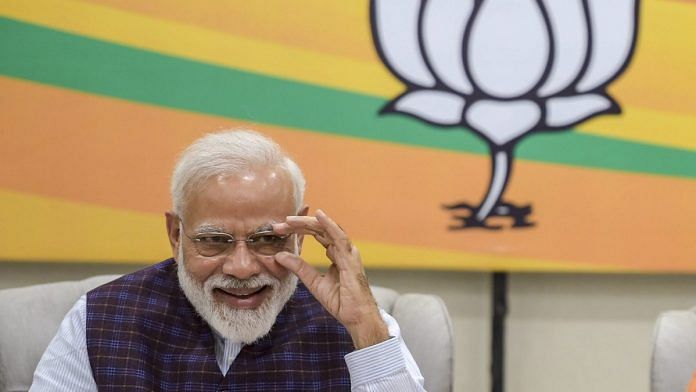The worst fear of the D-street is the prospect of the seventeenth Lok Sabha after 2019 elections looking more like the one in 1996. But this is highly unlikely.
Besides targeting the Congress, Prime Minister Narendra Modi has been repeatedly reminding the voters in every speech to reject the regional coalitions, calling them sarab and maha-milawat. The BJP would not like to repeat the acts of commission and omission that its leadership did in 1996 and allow India to go through an unwieldy federal coalition government.
But 2019 is not 1996.
After the fifth phase of Lok Sabha polling, 424 of the 543 constituencies have already voted. Polling for the remaining 118 seats will be over in the next two phases by 19 May.
Also read: To be relevant in 2019, Congress must rewind to 1996-2004
What happened in 1996?
The Congress government led by veteran leader P.V. Narasimha Rao was facing a series of corruption charges ahead of the 1996 elections.
It was advantage Bharatiya Janata Party (BJP) then, but there were strong non-Congress, non-BJP political leaders in the states who enjoyed huge political clout. Regional parties were not willing to back either the Congress, which had emerged as the second-largest party with 140 seats, or the BJP, which had 161 seats and was the single-largest party after the 1996 Lok Sabha elections.
I was a witness to then-BJP leader Atal Bihari Vajpayee sending the olive branch to various regional parties, particularly to G.K. Moopanar of the Tamil Maanila Congress (the DMK-TMC-CPI combine had won all the 39 seats in Tamil Nadu) who demanded to be made the deputy Prime Minister.
Also read: Why 2019 may not turn out to be like 2004
Other parties too placed demands disproportionate to their strength in the Lok Sabha. As a result, Vajpayee ended up being a 13-day Prime Minister. The United Front, an alliance between various regional parties, finally formed the government, but it didn’t last the entire tenure. And, the BJP again came back to power in 1998.
Why 2019 is not 1996
This time, the fears about a 1996-style divided Lok Sabha are misplaced.
In 1996, the Congress was the main pole around which other opposition parties had rallied. The BJP then was emerging as an alternative.
In 2019, the Congress, although a pan-India party, is ruling few states; its leadership lacks cadre support; the party has failed to provide a strong and convincing alternative to the BJP’s governance model. It has no strong allies, who can derive any benefit from transfer of votes.
The BJP, on the other hand, has been strategically forming alliances in key states. It has also managed to placate upset coalition partners ahead of the elections.
Unlike 1996, this time around, the non-Congress, non-BJP parties have no tall leaders nor do they have a common agenda. In their unholy haste to storm into the centre of political power, these parties have tried to enter into a marriage of convenience but in vain.
In their pursuit of power, these parties have managed to keep the Congress out of coalition, thereby scripting a three-cornered (or in some places four-cornered) contest, which is likely to go in the BJP’s favour.
A weak Congress and a fragmented opposition that has failed to take up voters’ cause will help the BJP this election.
The BJP, on the other hand, has been making a strong pitch for national security and a stable government in its election campaign.
Also read: This is what has angered Narendra Modi this Lok Sabha election
The party and its strategists have learnt their lessons from 1996 – regional parties guard their turf and vote bank zealously, and seldom cede space to national parties.
Yet, regardless of ideology or pre-poll acrimony, these parties also want to have a say in central decision-making in New Delhi. That’s why, they continue to be a part of coalitions run by either the BJP or the Congress. And, the BJP knows this only too well.
The author is former editor of ‘Organiser’. Views are personal.







most likely scenario NDA 170 plus seats and UPA and Others 360 plus. OTHERS -2 means TRS, YSR Congress, BJD, MNF and other minor parties should get 100 plus seats to form NDA Government. Ground reality shows that it is difficult. UPA is the most favoured alliance for OTHERS – 1 means TMC, TDP, SP, BSP and other minor parties. If OTHERS -1 gets 110 plus seats then UPA to form Government. This is the most likely scenario. If NDA brings OTHERS 1 and 2 then NDA will form Government.
2019 is not 1996 for the Congress as well. With the same 140 by which it missed the bus eight years earlier, the party formed the government in 2004, which ruled for a decade. In 1996, the BJP was still largely untouchable for most regional parties. It is a tribute to Vajpayeeji’s statesmanship and large heart that he changed that dynamic completely. 2. After 23rd May, there will be powerful regional leaders who could have swung either way. However, the desire to expand geographical footprint, giving existing allies slim pickings, the hard edge to identity, again mean that most regional parties would look to the Congress to form the coalition. In a different context, Mamatadi with her 35 MPs could have been a prize catch. 3. We are returning to the era of coalitions. This tutorial applies equally to the Congress. It needs to go some way in dealing better with existing and potential allies.